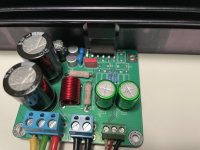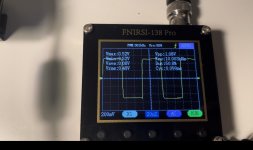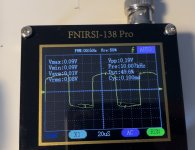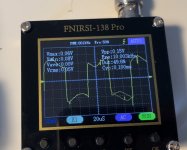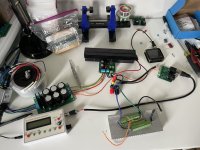I recently saw a post on a FB EE group where the writer strongly discouraged readers from immersing those big resistors in water in order to run them above their rating. He said he once did that and the resistor exploded due to water ingress (which turned to steam).
I had a chance to test LM3886 using square wave generator on low gains like 3.3x 4.7x 8.2x 9.1x and 10x.
To see the full picture, I started square wave generator output at 0V and gradually increased the output up to where I was getting 22Vrms from LM3886. At that level LM3886 was maxed out. Technically it was maxing out around 17V to 18V.
Used linear PSU with Antek AN-2222 200VA 22V secondaries.
Input resistor was 1K and feedback resistors were changed for every test.
At 3.3x gain with no compensation at all LM3886 was able to go up to 10Vrms output. More than that and it was breaking into oscillation.
At 4.7x gain no compensation I was able to get output up to 14Vrms.
At 8.2x gain got 17Vrms out.
At 9.1x got 18Vrms out.
Atx 10x got 18Vrms out.
In all the cases above square wave on the output was a perfect square. That applies for output level or 0.05Vrms, 0.1Vrms, 1Vrms, and up to the level right before the clipping.
To see the full picture, I started square wave generator output at 0V and gradually increased the output up to where I was getting 22Vrms from LM3886. At that level LM3886 was maxed out. Technically it was maxing out around 17V to 18V.
Used linear PSU with Antek AN-2222 200VA 22V secondaries.
Input resistor was 1K and feedback resistors were changed for every test.
At 3.3x gain with no compensation at all LM3886 was able to go up to 10Vrms output. More than that and it was breaking into oscillation.
At 4.7x gain no compensation I was able to get output up to 14Vrms.
At 8.2x gain got 17Vrms out.
At 9.1x got 18Vrms out.
Atx 10x got 18Vrms out.
In all the cases above square wave on the output was a perfect square. That applies for output level or 0.05Vrms, 0.1Vrms, 1Vrms, and up to the level right before the clipping.
Attachments
Last edited:
Here I am trying to attach a video for 3.3x gain with 33pF cap in parallel with feedback resistor.
I start from the lowest level and gradually increase the level up to 20Vrms measured at the output of the LM3886.
I then gradually decrease the level all the way down to ~0.01Vrms.
It looks like LM3886 has additional circuits that were not depicted in the data sheet (spike protection comes to mind).
My assumption is that those could be causing this strange behavior for the square wave.
In conclusion, I will not be using LM3886 at such low gain.
https://drive.google.com/file/d/1JNocnQypzunwc7Nr6tw7IssJ7xMq8Woj/view?usp=drivesdk
I start from the lowest level and gradually increase the level up to 20Vrms measured at the output of the LM3886.
I then gradually decrease the level all the way down to ~0.01Vrms.
It looks like LM3886 has additional circuits that were not depicted in the data sheet (spike protection comes to mind).
My assumption is that those could be causing this strange behavior for the square wave.
In conclusion, I will not be using LM3886 at such low gain.
https://drive.google.com/file/d/1JNocnQypzunwc7Nr6tw7IssJ7xMq8Woj/view?usp=drivesdk
Last edited:
I also testet 47pF and 100pF caps over the feedback resistor. Same issue with the square wave - except even worse.
Another test I ran was adding resistor in series with cap. Basically RC network of 3.3k and 33pF in parallel to 3.3k feedback resistor. Input resistor was set to 1k.
Attached is the photo of the testing setup. I am not using anything fancy as this is just a hobby.
Another test I ran was adding resistor in series with cap. Basically RC network of 3.3k and 33pF in parallel to 3.3k feedback resistor. Input resistor was set to 1k.
Attached is the photo of the testing setup. I am not using anything fancy as this is just a hobby.
Attachments
Im pretty confident in oscilloscope, but not so confident in that square wave generator.
What is interesting, is if I set the gain to 9.1x I get perfect square waves reading on oscilloscope - except small spikes on top and bottom.
I will try to attach a link to the video below:
gain is 9.1x and no compensation caps are used:
https://drive.google.com/file/d/1K-Y_jf9KmP88UHYHMeeoh69szfahPH7E/view?usp=drivesdk
What is interesting, is if I set the gain to 9.1x I get perfect square waves reading on oscilloscope - except small spikes on top and bottom.
I will try to attach a link to the video below:
gain is 9.1x and no compensation caps are used:
https://drive.google.com/file/d/1K-Y_jf9KmP88UHYHMeeoh69szfahPH7E/view?usp=drivesdk
Attachments
- Home
- Amplifiers
- Chip Amps
- What gain is safe to use for LM3886?
